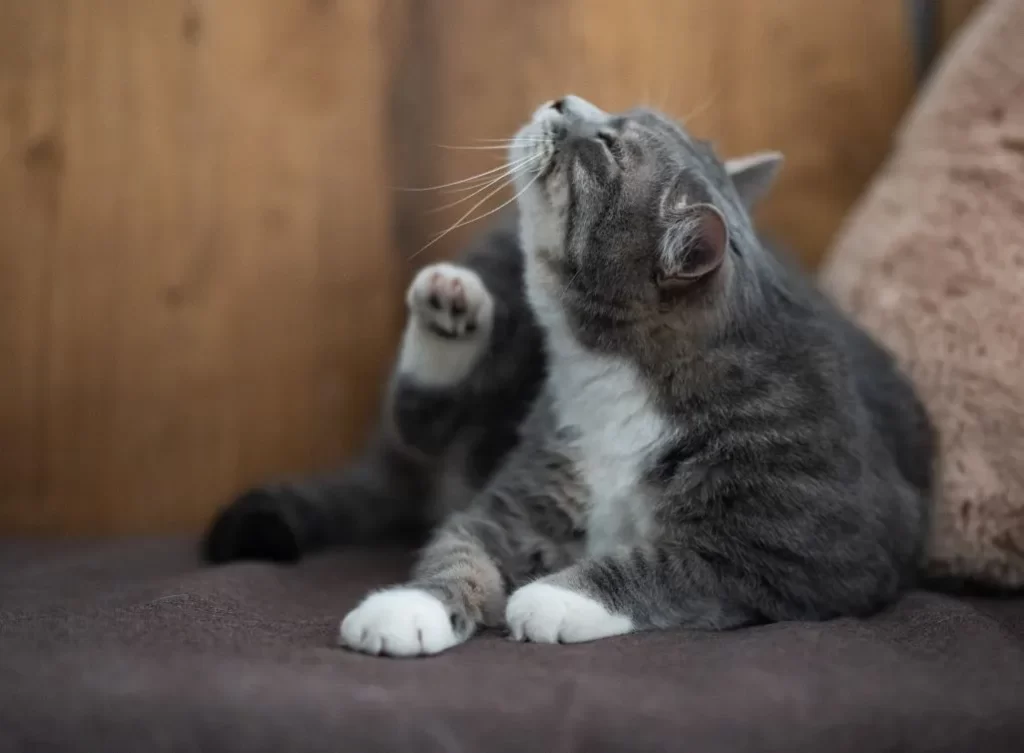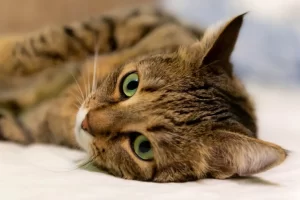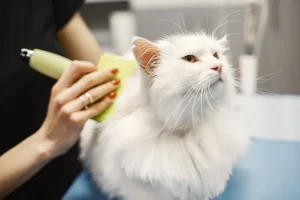Cats are susceptible to various types of infections, and one of the most common is yeast infection. Yeast infections in cats can be caused by a variety of factors, including an overgrowth of naturally occurring yeast, underlying medical conditions, and exposure to allergens. Symptoms of a cat yeast infection can include itching, redness, and discharge from the ears, as well as skin irritation and hair loss. In this article, we will cover the causes, symptoms, and traditional medical treatments for cat yeast infections as well as home remedies, diet changes, and other preventative measures. Additionally, we will discuss how to spot complications, provide supportive care, and improve your cat’s overall immune system to help prevent future yeast infections.
Table of Contents
ToggleWhat causes a yeast infection?
A yeast infection is a type of fungal infection caused by an overgrowth of the yeast Candida. Yeast infections can occur in various parts of the body, including the ears, skin, and paws.
Causes of cat yeast infections:
- Overgrowth of naturally occurring yeast on the skin or in the ears
- Antibiotic use, which can disrupt the balance of bacteria in the body
- Immune system suppression
- Hormonal imbalances
- Allergies or other skin irritations
- A diet high in sugar or carbohydrates
- Exposure to mold or damp environments
- Chronic or recurrent ear infections
- Other underlying medical conditions
- Unhygienic environment
- Grooming issues
- Genetics
It’s important to note that yeast infections can have multiple causes and it is important to consult with a veterinarian to rule out any underlying health issues.
Check out our post on: How often do you take a cat to the vet?
Symptoms of cat yeast infections
Symptoms of cat yeast infections can vary depending on the location of the infection.
- Yeast infections in the ears: Symptoms may include itching of the ears, redness, and discharge from the ears that is dark, waxy, and has a strong odor. The ears may appear swollen and have a strong, musty odor. The cat may also shake its head or scratch its ears excessively.
- Yeast infections on the skin: Symptoms may include itching, redness, and hair loss. The skin may appear crusty, scaly, and dark. Swelling and thickening of the skin may also be visible. The cat may also scratch excessively.
- Yeast infections on the paws: Symptoms may include redness, itching, and hair loss on the paws. The paws may appear swollen and have a strong odor. The cat may also lick its paws excessively.
Note that all cats may show different signs and symptoms and it is best to consult with a veterinarian for a proper diagnosis. Additionally, yeast infection can also be systemic, which means it can affect multiple areas of the body at once, thus can show multiple signs and symptoms.
How to diagnose cat yeast infections
The most effective way to diagnose a yeast infection in cats is through a combination of a physical examination, medical history, and laboratory tests.
- Physical examination: Your veterinarian will conduct a thorough examination of your cat’s skin, ears, and paws, looking for signs of redness, itching, discharge, and odor. They may also take skin or ear swabs to collect samples for laboratory analysis.
- Medical history: Your veterinarian will ask you about your cat’s recent medical history, including any medications they are taking, their diet, and any previous yeast infections or other skin conditions.
- Laboratory tests: Your veterinarian may send samples collected during the physical examination to a laboratory for analysis. These tests may include skin or ear cultures, which can help identify the type of yeast present and determine if it is the cause of the infection. Blood tests may also be done to check the overall health of the cat and to rule out other underlying medical conditions that may be contributing to the infection.
It is important to note that yeast infection can be mistaken for other conditions like allergies, hormonal imbalances, and other skin conditions. Therefore, a proper diagnosis from a veterinarian is necessary to ensure the best treatment plan for your cat.
Medical treatments and medicines for cat yeast infections
The most common treatments for yeast infections in cats include:
- Antifungal medications: These are used to kill the yeast and include shampoos, creams, and oral medications such as itraconazole, terbinafine, and fluconazole.
- Topical medications: These include creams, gels, and sprays that can be applied directly to the affected area to soothe itching and reduce inflammation.
- Antibiotics: If a secondary bacterial infection is present, antibiotics may be prescribed to kill the bacteria and prevent it from spreading.
- Steroids: If your cat has a severe reaction to the yeast infection, a short course of steroids may be prescribed to reduce inflammation and itching.
- Medicated shampoos: Antifungal and medicated shampoos can be used to clean the affected area and help remove any discharge.
- Immune modulators: These can help boost the cat’s immune system to fight off the infection and prevent a recurrence.
Common medicines for cat yeast infections include:
- Clotrimazole
- Miconazole
- Ketoconazole
- Nystatin
- Itraconazole
- Fluconazole
- Terbinafine
- Enilconazole
- Chlorhexidine
It is important to note that yeast infection treatment can take several weeks or even months and that the cat should be monitored by a veterinarian during the course of the treatment to ensure that the infection is cleared and to adjust the treatment if necessary.
Home remedies for cat yeast infections
There are several home remedies that can be used to help alleviate symptoms of cat yeast infections and promote healing. These remedies can be divided into the following categories:
- Diet: switching to a diet that is low in carbohydrates and high in protein, as well as eliminating processed foods, can help reduce the growth of yeast in the cat’s body.
- Natural supplements: certain supplements such as probiotics, omega-3 fatty acids, and antioxidants can help boost the cat’s immune system and reduce inflammation.
- Topical remedies: using natural oils and herbs, such as coconut oil, tea tree oil, and calendula, can help soothe itching and reduce inflammation.
- Cleaning and hygiene: keeping the cat’s ears, paws, and skin clean and dry can help prevent the growth of yeast.
It is important to note that home remedies should be used under the guidance of a veterinarian and that these remedies are not a substitute for traditional medical treatment. Additionally, it is important to address the underlying cause of the infection and to prevent recurrence by maintaining a healthy diet, good hygiene and regular check-ups with the veterinarian.
Dietary changes for preventing and treating cat yeast infections
- Switch to a diet that is low in carbohydrates and high in protein. A diet that is high in protein and low in carbohydrates can help reduce the growth of yeast in the cat’s body. Examples of high protein, low carbohydrate diets include raw meat, fish, or poultry and specially formulated grain-free or carbohydrate-free diets.
- Eliminate processed foods, as they contain preservatives, artificial colors, and flavorings that can contribute to yeast overgrowth. Examples of processed foods include canned or dry cat food, treats, and snacks that contain artificial ingredients or preservatives.
- Feed a diet that is high in essential fatty acids, such as omega-3 and omega-6, which have anti-inflammatory properties. Examples of foods that are high in essential fatty acids include fatty fish, flaxseed oil, and fish oil supplements.
- Incorporate probiotics into the diet, which can help balance the bacteria in the gut and boost the immune system. Examples of probiotics include yogurt, kefir, and supplements that contain live cultures.
- Try to avoid feeding your cat foods that contain high levels of sugar or yeast, such as bread or beer.
- Avoid feeding high carbohydrate foods like grains and potatoes.
It is important to note that dietary changes should be made under the guidance of a veterinarian, as certain dietary restrictions may not be appropriate for all cats.
Natural supplements for cats with a yeast infection
- Probiotics: Probiotics can help balance the bacteria in the gut and boost the immune system. They can be found in yogurt, kefir, and supplements that contain live cultures.
- Omega-3 fatty acids: Omega-3 fatty acids have anti-inflammatory properties that can help reduce inflammation and itching associated with yeast infections. They can be found in fatty fish, flaxseed oil, and fish oil supplements.
- Antioxidants: Antioxidants can help boost the immune system and protect against infections. They can be found in fruits and vegetables, such as berries, spinach, and sweet potatoes.
- Vitamin C: Vitamin C is an antioxidant that can help boost the immune system and reduce inflammation. It can be found in citrus fruits, such as oranges, lemons, and limes, as well as in supplements.
- Vitamin E: Vitamin E is an antioxidant that can help reduce inflammation and improve skin health. It can be found in foods such as nuts, seeds, and leafy greens, as well as in supplements.
It is important to note that natural supplements should be used under the guidance of a veterinarian and that these supplements are not a substitute for traditional medical treatment.
Topical remedies (natural oils and herbs) for cats with a yeast infection
Oils:
- Tea tree oil: Tea tree oil has anti-fungal properties that can help to combat yeast infections. It can be used by diluting a few drops of tea tree oil with a carrier oil such as coconut oil, and then applying it to the affected area.
- Oregano oil: Oregano oil has anti-fungal and anti-inflammatory properties that can help to combat yeast infections. It can be used by diluting a few drops of oregano oil with a carrier oil such as coconut oil, and then applying it to the affected area.
- Olive oil: Olive oil has anti-fungal properties that can help to combat yeast infections. It can be used by applying a small amount of olive oil to the affected area.
- Coconut oil: Coconut oil has anti-fungal properties that can help to combat yeast infections. It can be used by applying a small amount of coconut oil to the affected area.
- Sweet almond oil: Sweet almond oil has anti-inflammatory properties that can help to reduce inflammation and itching associated with yeast infections. It can be used by applying a small amount of sweet almond oil to the affected area.
- Jojoba oil: Jojoba oil can help to soothe irritated skin and has anti-inflammatory properties that can help to reduce inflammation and itching associated with yeast infections. It can be used by applying a small amount of jojoba oil to the affected area.
Herbs:
- Garlic: Garlic has anti-fungal properties that can help to combat yeast infections. It can be used by crushing a few cloves of garlic and then applying it to the affected area.
- Calendula: Calendula has anti-inflammatory properties that can help to reduce inflammation and itching associated with yeast infections. It can be used by making a tea from the dried flowers and then applying it to the affected area or using calendula oil.
- Neem: Neem has anti-fungal and anti-inflammatory properties that can help to combat yeast infections. It can be used by making a paste from the leaves and then applying it to the affected area or using neem oil.
- Echinacea: Echinacea has anti-inflammatory properties that can help to reduce inflammation and improve skin health. It can be used by making a tea from the dried flowers and then applying it to the affected area.
- Aloe vera: Aloe vera has anti-inflammatory properties that can help to reduce inflammation and itching associated with yeast infections. It can be used by applying aloe vera gel to the affected area.
- Chamomile: Chamomile has anti-inflammatory properties that can help to reduce inflammation and itching associated with yeast infections. It can be used by making a tea from the dried flowers and then applying it to the affected area or using chamomile oil.
It is important to note that topical remedies should be used under the guidance of a veterinarian and that these remedies are not a substitute for traditional medical treatment.
Cleaning and disinfecting for cat yeast infection prevention
- Cleaning: It is important to keep the environment clean and free of debris to prevent the growth of yeast. This includes regularly cleaning the cat’s bedding, litter boxes, and other surfaces that the cat comes into contact with. It’s also important to vacuum and mops the floors, especially in areas where the cat spends a lot of time.
- Disinfecting: It is important to disinfect the environment to kill any remaining yeast. This can be done by using a solution of water and vinegar or water and hydrogen peroxide. Be sure to rinse thoroughly and dry the surfaces afterward.
- Maintaining good hygiene: To prevent the recurrence of yeast infections, it is important to maintain good hygiene. This includes regular grooming of the cat, keeping their ears clean and dry, and keeping the litter boxes clean.
- Avoiding damp and warm areas: Yeast thrives in warm and humid environments, so it’s important to keep the cat’s living area cool and dry. It’s also important to avoid overcrowding the living area and to provide adequate ventilation.
It is important to note that, even with a good cleaning and disinfecting practices, it is still possible for a cat to develop a yeast infection
How to prevent yeast reinfection
Follow a treatment plan: It is important to follow the treatment plan prescribed by a veterinarian, which may include medication and changes to the cat’s diet or environment.
- Maintain good hygiene: Regular grooming, keeping the ears clean and dry, and keeping the litter boxes clean can help prevent the growth of yeast.
- Avoiding damp and warm areas: Yeast thrives in warm and humid environments, so it’s important to keep the cat’s living area cool and dry. It’s also important to avoid overcrowding the living area and to provide adequate ventilation.
- Address underlying medical conditions: Yeast infections can often be caused by underlying medical conditions such as diabetes, allergies, or immune system disorders. It’s important to address these underlying conditions to prevent recurrence of the yeast infection.
- Consider prophylactic treatment: In case of recurrent infections, your vet may recommend prophylactic treatment, which will help to prevent the infection from recurring.
- Regular check-ups: Regular check-ups with the veterinarian can help to catch any signs of reinfection early on, and make sure that the treatment plan is working effectively.
It is important to note that preventing reinfection may take some time and effort, but with proper care and attention, it is possible to keep your cat healthy and free from yeast infections.
How to spot complications and when to seek veterinary care for a cat yeast infection
Follow these steps or instructions:
- Monitor the cat’s symptoms: It is important to monitor the cat’s symptoms and to pay attention to any changes. This includes watching for signs of redness, itching, or discharge, as well as any changes in the cat’s behavior or appetite.
- Know the common complications: Common complications of yeast infections include secondary bacterial infections, which can cause fever, lethargy, and loss of appetite. If the infection spreads to other parts of the body, it can also lead to more severe complications such as sepsis.
- Keep an eye on the cat’s overall health: Yeast infections can also be a sign of underlying medical conditions, such as diabetes or immune system disorders. It’s important to keep an eye on the cat’s overall health and to seek veterinary care if there are any concerns.
- Seek veterinary care: It is important to seek veterinary care if the cat’s symptoms do not improve or if they worsen. A veterinarian will be able to diagnose the infection and recommend a treatment plan.

How to groom a cat with a yeast infection
Here are steps to follow to groom a cat with a yeast infection:
- Clean the ears: Yeast infections often occur in the ears, so it’s important to keep them clean and dry. Use a cotton ball or a soft cloth to wipe the inside of the ears, and make sure to remove any discharge or debris.
- Trim hair around affected areas: Long hair around the ears or paws can trap moisture and create an ideal environment for yeast growth. Trim the hair around affected areas to keep the skin dry.
- Bathe the cat: A medicated shampoo can help to eliminate yeast and soothe irritated skin. Follow the instructions on the shampoo, and make sure to rinse the cat thoroughly.
- Dry the cat: Make sure to dry the cat completely after bathing or washing affected areas. Use a clean towel or a hairdryer on a low setting.
- Clean the litter box: Clean the litter box regularly, as yeast can thrive in warm, moist environments.
It is important to note that grooming a cat with a yeast infection should be done with care, as the cat may be sensitive to touch.
How to recognize and address potential allergens
- Recognize the symptoms: Cats with yeast infections may also have symptoms of allergies such as itching, redness, and inflammation. If your cat’s symptoms persist despite treatment for yeast infection, it may be worth considering the possibility of an underlying allergen.
- Keep a diary: Keep a diary of your cat’s symptoms, including when they occur and what may have triggered them. This can help you and your veterinarian to identify potential allergens.
- Look for patterns: Look for patterns in your cat’s symptoms, such as whether they occur more frequently at certain times of the year or after exposure to certain substances.
- Eliminate potential allergens: Once potential allergens have been identified, it may be necessary to eliminate them from your cat’s environment. This may include removing certain types of food from the cat’s diet, avoiding certain types of litter, or removing certain types of plants from the cat’s environment.
- Allergy testing: In some cases, your veterinarian may recommend allergy testing, such as blood or skin tests, to determine the specific allergens that are causing the cat’s symptoms.
It is important to note that allergies can be a complex condition, and it may take some time to identify the specific allergens that are causing your cat’s symptoms. Additionally, addressing allergens may require a multi-faceted approach, which may include dietary changes, environmental changes, and medications or supplements to control symptoms.
Is a cat yeast infection contagious?
Yeast infections in cats are not considered contagious, as they typically occur as a result of an imbalance in the cat’s own immune system or in the environment. Yeast infections can be caused by a variety of factors, including allergies, hormonal imbalances, and certain medical conditions. While a yeast infection in one cat may not necessarily spread to other cats, it is possible for cats living in the same environment to be exposed to the same factors that contribute to the development of a yeast infection.
It’s worth noting that some yeast infections can be caused by external factors such as contaminated food, water or bedding, in such cases other cats living in the same environment may be at risk.
What happens if a cat yeast infection is left untreated?
If a cat yeast infection is left untreated, it can lead to a number of serious health problems. Some of the risks associated with untreated yeast infections in cats include:
- Spread of the infection: If left untreated, a yeast infection can spread to other parts of the body, leading to more severe symptoms and potentially serious complications.
- Secondary infections: Yeast infections can also lead to secondary bacterial infections, which can be even more difficult to treat and can cause serious health problems.
- Chronic health problems: Untreated yeast infections can lead to chronic health problems, such as chronic skin irritation, recurrent ear infections, and chronic respiratory infections.
- Reduced quality of life: Yeast infections can cause a lot of discomfort and can significantly reduce a cat’s quality of life. Symptoms such as itching, redness, and inflammation can make it difficult for a cat to sleep, eat, and move around comfortably.
- Allergic reactions: Some cats may develop an allergic reaction to yeast. This can lead to symptoms such as itching, redness, and hives, and can be serious if left untreated.
- Immunosuppression: Yeast infections can also suppress the cat’s immune system, making it more susceptible to other types of infections.
It is important to seek veterinary care as soon as possible if you suspect that your cat may have a yeast infection. The earlier the infection is diagnosed and treated, the less likely it is to cause serious health problems.
Will a cat yeast infection go away on its own?
It is possible for a yeast infection to go away on its own in some cases, but it is not recommended to wait for it to happen. Yeast infections in cats often occur as a result of an underlying problem or imbalance in the cat’s body, and without proper treatment, the infection can persist and even worsen over time.
Also, it may seem like the infection has resolved but it might come back again if the underlying cause is not addressed. For example, if the yeast infection is caused by an underlying allergy or hormonal imbalance, it will likely recur if these underlying issues are not addressed.
Additionally, leaving a yeast infection untreated can lead to the development of secondary infections, which can be even more difficult to treat and can cause serious health problems.
Choosing the right veterinarian for cat yeast infection treatment
If you suspect that your cat has a yeast infection, it is important to visit a veterinarian for proper diagnosis and treatment. The veterinarian will perform a physical examination, take a medical history, and may recommend diagnostic tests such as blood work, skin scraping, and culture, to confirm the diagnosis of yeast infection and rule out other possible causes.
The veterinarian you should visit depends on the symptoms and suspected location of the yeast infection. Here are some specialties that may be involved:
- A general practitioner (GP) veterinarian can diagnose and treat the most common types of yeast infections in cats.
- If the infection is in the ears, your cat may need to see a veterinarian who specializes in treating ear problems, known as an otolaryngologist.
- If the infection is in the skin, your cat may need to see a veterinarian who specializes in treating skin problems, known as a dermatologist.
- If the infection is in the nails or paws, your cat may need to see a veterinarian who specializes in treating podiatry problems.
- If the infection is systemic, your cat may need to see a veterinarian who specializes in internal medicine.
Costs of treating yeast infections in cats: An overview
The costs associated with treating a yeast infection in a cat can vary depending on the location and severity of the infection, as well as the specific treatment plan recommended by the veterinarian. Here are some general costs that may be associated with different steps of treating yeast infections in cats:
- Initial veterinary visit: The cost of an initial veterinary visit for a cat with a suspected yeast infection can range from $50 to $200, depending on the location and services provided by the veterinarian.
- Diagnostic tests: Depending on the case, diagnostic tests such as blood work, skin scraping, and culture may be necessary. These can range from $50 to $200.
- Medication: Antifungal medications, such as topical or oral antifungal creams or pills, are often prescribed to treat yeast infections in cats. These medications can range from $10 to $50 per month.
- Recheck examination: A recheck examination with the veterinarian after a certain period of treatment is recommended, this can range from $50 to $100.
- Specialty care: If the yeast infection is severe or located in a specific area, such as the ears or paws, your cat may need to see a specialist. Specialty care can be more expensive and can range from $200 to $1000.
- Supportive care: Depending on the case, supportive care may also be recommended such as dietary changes, supplements, and grooming. The costs associated with these can vary, but can range from $50 to $200.














